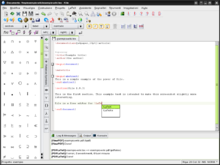- Text Model Linux Can Be Recompiled For Mac Os X 10.6.8
- Text Model Linux Can Be Recompiled For Mac Os X
Both macOS—the operating system used on Apple's desktop and notebook computers—and Linux are based on the Unix operating system, which was developed at Bell Labs in 1969 by Dennis Ritchie and Ken Thompson. The operating system used on Apple's iPhones, now called iOS, is derived from macOS and therefore also a Unix variant.
Like all major Linux distributions, such as Ubuntu, Red Hat, and SuSE Linux, macOS offers a desktop environment that provides a graphical user interface to application programs and system settings. This desktop environment is built on top of a Unix-type OS just as the desktop environments of Linux distros are built on top of the core Linux OS. However, Linux distros usually offer alternative desktop environments besides the one installed by default. Microsoft Windows and macOS don't give users the option to switch desktop environments, other than minor look-and-feel adjustments such as color schemes and font size.
I use sudo su command to do something in Mac OS X but don't know how to switch back. Hope you guy can do me a favour.
The Common Roots of Linux and macOS
The practical aspect of the common roots of Linux and macOS is that both follow the POSIX standard. POSIX stands for Portable Operating System Interface for Unix-like Operating Systems. This compatibility makes it possible to compile applications developed on Linux on macOS systems. Linux even provides options to compile applications on Linux for macOS.
Like Linux distros, macOS includes a Terminal application, which provides a text window in which you can run Linux commands. This terminal is also often referred to as command line or shell or shell window. It's the text-based environment that people used to operate computers before graphical user interface became available. It is still widely used for system administration and scripting automated processes.
The popular Bash shell is available in macOS as it is in pretty much all Linux distributions. The Bash shell helps you to quickly traverse the file system and start text-based or graphical applications.
In a shell you can use all your basic Linux and shell commands such as ls, cd, cat, and more. The file system is structured as in Linux, with partitions such as usr, var, etc, dev, and home at the top, although there are some additional folders in macOS.

The basic programming languages of Unix-type operating systems such as Linux and macOS are C and C++. Much of the operating system is implemented in these languages, and many basic applications are implemented in C and C++ as well. Higher level programming languages such as Perl and Java are also implemented in C/C++.
Apple provides the Objective C programming language including an Integrated Development Environment called Xcode to support the development of applications for macOS and iOS.
Like Linux, macOS includes strong Java support and actually provides a custom Java installation to ensure seamless integration of Java applications. It also includes terminal-based versions of the text editors Emacs and vi, which are popular on Linux systems. Versions with more GUI support can be downloaded from Apple's AppStore.
Text Model Linux Can Be Recompiled For Mac Os X 10.6.8

Major Differences
One of the differences between Linux and Mac OS X is the kernel. The kernel is the core of a Unix-type OS and implements functions such as process and memory management as well as file, device, and network management. When Linus Torvalds designed the Linux kernel he opted for what is referred to as a monolithic kernel for performance reasons, as opposed the microkernel, which is designed for more flexibility. MacOS uses a kernel design that compromises between these two architectures.
Edit a video without using a mouse or trackpad. Build a presentation without seeing the screen. Or track down important files for your next project with just your voice. Because Mac is designed for everybody to create amazing things.
VoiceOverYou don’t need to see your Mac to use your Mac.
Text Model Linux Can Be Recompiled For Mac Os X
VoiceOver is a revolutionary built-in screen reader that’s more than a text-to-speech tool. It tells you exactly what’s on your screen and talks you through actions like editing a video, building a presentation, or quickly navigating from one app to another.
Dark ModeWorking hard gets easier on the eyes.

Dark Mode transforms the desktop and built-in apps with a new dark color scheme that helps you focus on your work.1 The fine points of your content take center screen as toolbars and menus recede into the background. Light text against darker backdrops in Mail, Safari Reader, Calendar, and more makes everything easier to read in low lighting conditions. And the Accessibility preferences for increased contrast and reduced transparency work with Dark Mode enabled.
SiriMake requests by talking or typing.
Siri on Mac lets you quickly find and open files, set reminders, send text messages, and more, making it easy to handle the things you do every day.2 With “Type to Siri” mode, you can make requests using a physical or onscreen keyboard. And Siri can also predict your next word based on what you’ve said before, so you can minimize typing over time.
Switch ControlNavigate your Mac with as little as a tap.
Create amazing things with your Mac without touching a mouse or keyboard. With Switch Control, you can navigate through onscreen keyboards, menus, and the Dock using a variety of switch options.
Text to SpeechGo from written word to spoken word.
If you learn better when you can hear what you’re reading or writing, Text to Speech lets you highlight any text and have your Mac read it aloud. And you can choose from more than 70 male or female voices across 42 languages.